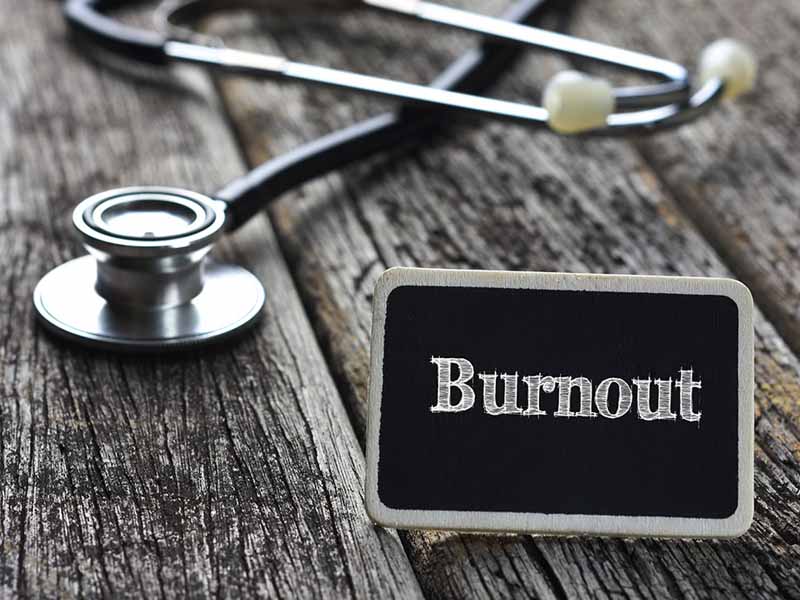Researchers Investigate Primary Care Professional Burnout
Root Cause: Underutilized Team-based Care
January 31, 2018, 12:29 pm News Staff – The patient-centered medical home (PCMH) and physician burnout may seem like an unlikely pairing for a research study. After all, the PCMH model was designed to provide better care to patients through team-based care and a variety of other practice improvements.

And, as authors of a study published in the January 2018 issue of the Journal of General Internal Medicine point out, "Effective task-sharing may reduce burnout among primary care providers (PCPs)."
But is it possible that physicians and other primary care professionals are shouldering an unhealthy load of patient-care duties in this setting? Should they be relying more on their team members?
Authors of the article, titled "Primary Care Tasks Associated with Provider Burnout: Findings from a Veterans Health Administration Survey," noted that the challenges that come with undergoing a practice change as immense as transitioning to a team-based model of care "may have led to the unintended consequences of creating new stresses for PCPs, resulting in burnout."
There are consequences beyond the toll taken on PCPs, as well: Burnout has been associated with a decrease in the quality of patient care and an increase in medical errors. Researchers also noted links to poorer patient health outcomes, lower patient satisfaction scores, overuse of resources and an increase in health care costs.
For all of those reasons, researchers set out to explore how much PCPs "share responsibility for 14 discrete primary care tasks with other team members" and which tasks PCPs take on without that shared responsibility from the care team were associated with PCP burnout.
It's important to note that for purposes of this study, researchers defined PCPs as physicians, nurse practitioners or physician assistants; 69 percent of PCPs who participated in the survey were physicians.
STORY HIGHLIGHTS
Study Methodology
Researchers looked at a small sliver of PCPs who took part in in a Veterans Health Administration (VHA) survey conducted in two waves -- from November 2011 to March 2012 and from August 2013 to January 2014. The 327 participating PCPs represented 23 primary care practices in five health care systems within one VHA regional network.
The web-based survey was administered by the RAND Corp. Burnout was measured using the emotional exhaustion subscale of the Maslach Burnout Inventory. PCPs responded to statements such as "I feel emotionally drained from my work," and "I feel burned out from my work." Response options for each of the nine statements ranged from "never" to "every day."
Learn to Conquer Burnout and Fatigue
Take this opportunity to explore resources that have been created just for family physicians as part of the AAFP's Physician Health First® initiative, including an interactive web portal with tools dedicated to improving physician well-being.
For family physicians not familiar with the operations of the VHA, in 2010, it implemented the Patient-Aligned Care Teams (PACT) model for the delivery of patient care in a PCMH-like setting. The core of the PACT model is the "teamlet," which is composed of a physician, nurse practitioner or physician assistant and three supporting team members -- a registered nurse care manager, a licensed vocational/practical nurse, and a medical assistant or clerical staff member.
The survey questions were built around 14 primary care tasks grouped into four general categories designated as
- patient assessment and treatment decisions,
- patient counseling and self-management education,
- followup with other clinician requests, and
- followup with patient requests.
Researchers measured responses regarding the extent to which each of the 14 tasks were performed by the PCP without help from team members.
Key Findings
Researchers broke down tasks PCPs reported performing independently. As noted in the findings,
- 87 percent of PCPs said they evaluated patients and made treatment decisions;
- 80 percent tracked patient diagnostic data and responded to patient diagnostic and treatment data;
- 68 percent intervened on patient lifestyle factors; and
- 65 percent educated patients about disease-specific self-care activities and medications.
PCPs reported some reliance on team members for screening patients for diseases (32 percent), receiving messages from patients (28 percent) and resolving patient messages (43 percent).
When it came to burnout, the researchers reported, "Specifically, intervening on patient lifestyle factors and educating patients about disease-specific self-care activities were significantly associated with PCP burnout."
Their suggestion: "Expanding the roles of nurses and other health care professionals to assume responsibility for these tasks may ease PCP burden and reduce burnout."
The researchers pointed out that existing literature identifies specific obstacles PCPs face in delivering these services, such as
- limited time,
- shortage of patient education resources,
- low self-efficacy in influencing patient behavioral change,
- perceived ineffectiveness of interventions, and
- skepticism about patient adherence to behavior modification.
"The association between these barriers and PCP burnout have not all been empirically tested in previous studies. However, researchers posit that these barriers, compounded by difficult patient encounters, can be a major source of frustration and stress, leading to job dissatisfaction and provider burnout," researchers said.
They suggested a potential strategy to combat PCP burnout would be to "enable PCPs to share this responsibility with other team members," a transition that would require adequate staffing, focused training and standing orders.
Authors called for additional research to consider how such task-sharing influences PCP burnout, "as well as the impact on staff burnout when they assume increased responsibility for such tasks."
Lastly, researchers confirmed that "team communication has a robust and consistent association with lower PCP burnout."
The study authors noted that although readers should take care when generalizing research findings within one VHA administrative region to primary care clinics in non-VHA health care settings, "previous studies investigating PCMH implementation have found that the challenges associated with PCMH implementation are common across primary care settings."